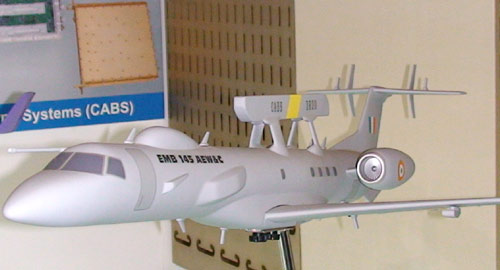Aiming to enhance the Indian Air Force's surveillance and strike capacity, India will begin integrating the indigenously-built Airborne Early Warning and Control (AEW&C) system atop the Brazilian Embraer aircraft in July, a top defence official said Saturday.
'The first Embraer plane (EMB-1451) will land in India by June-end after its power units have been connected to our airborne early warning radar fitted atop. Integration of its sub-systems will begin in July for user trials,' the defence minister's Scientific Advisor V.K. Saraswat told reporters here Saturday.
India placed the order, valued at $400 million, with Brazilian aerospace major Embraer to supply three aircraft, customised with advanced radars for induction into the Indian Air Force (IAF) by 2013.
The integration and flight tests will be undertaken in Bangalore by the Centre for Airborne System (CABS) in association with the Aeronautical Development Agency (ADA) of the state-run Defence Research and Development Organisation (DRDO).
'After the first plane was rolled out in February, the primary radar, identification-friend-or-foe (IFF) interrogator, communications and electronic intelligence receivers and data-processing systems are being integrated with the fuselage,' Saraswat said on the margins of the fifth Air Chief Marshal L.M. Katre memorial lecture here. Embraer will deliver the remaining two aircraft in 2012 and 2013. The aircraft was also modified to suit the Indian weather conditions and will be certified for airworthiness and user trials.
'The airborne radar is designed to detect and distinguish hostile aircraft and missiles, and help enhance IAF's surveillance and strike capability,' Saraswat said after delivering the Katre Memorial Lecture on 'Aerospace Technologies in the 21st century'.
The medium-range system can be used to direct fighter jets and other aircraft to their targets and warn them of enemy aircraft and missiles in the area, keeping a watch on the air and ground activities from miles away.
The EMB-145I aircraft has been modified to carry the Indian-made Active Array Antenna Unit (AAAU) mounted atop the plane's fuselage.
Katre was the 10th IAF chief but served for just 11 months from September 1984 to July 1985 due to his untimely demise. Prior to that, he was chairman of the state-run defence behemoth Hindustan Aeronautics Ltd (HAL) from March 1983 to September 1984.

No comments :
Post a Comment